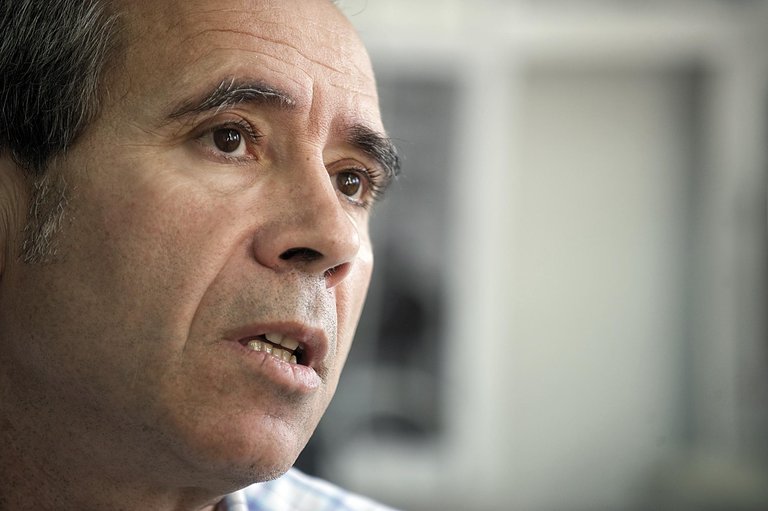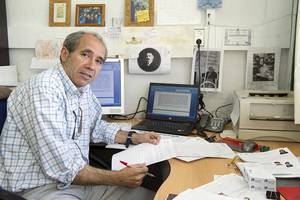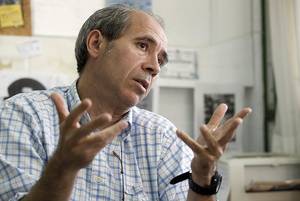"Language is a tool that exists and I care how to use it"

Yes... I have a friend of Assisi and I have become editor in this book, more or less. The road has a lot to see, I explain it to you. While doing Aldude's doctor, Etxepare spoke in the papers of his professor Jean Etxepare, Arnaut Abadia. Always, for good: perfect teacher, hard, "in bitter smell"... says things like this. On the other hand, he says he was a "skilled writer" and had prepared an anthology for publication, with the writings of Abbey.
The abbey brought weekly, for years, a column for the farmers. And this [Etxepare] says it was exemplary. But that was not published.
And I, then doing Etxepare, stayed: "What is there here? ". Neither Villasante in History of Basque Literature nor anyone mentions that Arnaut Abbey. Why? These pillars were published in a magazine, in the magazine Eskualduna, where they were buried, since the magazine Eskualduna has not been available for a long time.
And with a chiripa like this, another friend, Josu Landa, from Armiarma, told me that they had digitized him. What is already on the net happened to me. And I was 2-3 years reading Abbey every night. I read all the columns, of which I chose about 50 columns on animals and thought I also did an anthology. And like all were animals, because the illogical Zoo.
I did not want to make such a critical, philological, historical, gray, boring edition. To that I wanted to give another brightness, joy, a new diffusion. And I thought how to make it attractive. So with some images. Then I spoke to Asisco and he was very willing. Then I made an introduction to the book to present Abbey and put it in shape. And the edition has made it Pamiela, a very nice edition, I think.
I don't know if it will be read, but good! What is the intention? Not only to make Abbey known as a person, in those columns there is a style that is made. It must be demonstrated. XIX. In the twentieth century we have a classic that shows how things were done easily, public, I will not say illiterate, but yes for a very illiterate, and texts of complications, but of great grace. For example, what it says about the tope, or about the topo, or about the swallows, both nocturnal, bats, and daily… it is very nice. To my surprising taste.
Pity they are very disconnected articles. That is why it is "illogical zoo". I miss some species. For example, why you have not put the fox, or the badger, or the spleen... That is, for the Baserritarras, for the peasants, for the farmers, at a time there are not very close people. On the other hand, I have not been able to clarify which bibliographic sources came to. In fact, many things are yours, but others are seen to be read elsewhere.
Hence, critics can come from the philologists. The initial idea was to transcribe original texts with the current graph. But it was there, those of Armiarma hung those texts in the web. Then it no longer made sense to see the original in one click and put an "x" in the place where "ch" appeared in me. I thought I needed a deeper makeup. Then, I decided to put in common all the auxiliary verbs to facilitate reading. Above all I have done it, without touching it "laborarier", etc. I have thus left "laborarier" instead of "farmers". Therefore, there are forms that move away from the traditional unified Basque language, but that are the unified Basque language.
No, no, that's been something you liked. I'm not a player. Now it has been published and recently I read that it was the most sold in the Ortzadar supplement of Deia. I didn't believe it, but well. [The list of the best-selling books of the Rainbow supplement of 3 March 2012 appears in the Ficciones section].
They are not fictitious and, in that sense, there is no creative work, but documentation, and more than historical are contextualizations of certain characters. There is a documented review of the character environment. And they are biographies, but they are excuse to explain biological phenomena.
I have chosen...I do not know to what extent I have chosen, or, like that Pedantry which some say, have chosen me. But to some extent it is so. For example, historically, he was the first of Folin [ Marquis de Folin: Rodents and Basques on the lost island ]. And there was a sort of carambola. I knew the Marquis of Folin for my research. I had several works around the northern snails, and I knew those works. And I intended to present that character, with an article or.
Just those years, Jon Juaristi took The Lineage of Aitor, and there I read an appointment about Arana Goiri, saying that he saw the origin of the Basques in Atlantida. But that was a madness to deny the links with Spain.
But at fifteen days or, of course, he was reading other things from Folin and, of course, it was from the same time, and he too, based on those snails he saw, said that "these snails show us that the Basques are from Atlantida." It is not possible! ". And there I had many interrelated threads, what more interesting it seemed to me, and thanks to that I made friends of Asisko, among others.
When I was preparing that book, reading things about that time, I met Armand David, until then unknown to me. And I started to read more, Auñamendin, who went to China and China, where "a black and white bear" appears... Then I thought "Panda, it won't be true! ". And yes, Armand David, the puppy of Ezpeleta, was the first to describe panda.
Throwing away him, I discovered a huge interest rate, a cryptoeuskaldun, his brother bertsolari, he discovered the Panda tree and Davidia tangled... That is, a brilliant naturalist, a spy and an evolutionist! Surprising, in those times, in France, that a cure is evolutionist, of the first batch. And, in addition, it made me think about scientific nationalism and about these kinds of things.
By then I had already realized that, reading Gouldi and [Stephen Jay Gould, paleontologist and biologist], research was as interesting as research. That is, researching about natural selection can be very interesting, but seeing the concept of natural selection and the theoretical construction that underlies it is also at the level of the other. Why was Darwin what everyone knew what he really saw? That is the question.
From there came Armand David, the father of Panda.And Armand David took me to Etxepare. And he intervened me and grew up. From there came Etxepare, a doctor from Aldune. There we have a Basque, very cosmopolitan, born in a corner of the mountain, totally unknown, but modern, and, to compare it with a acquaintance, somehow, in the style of Pío Baroja, who, despite being of Lotilandia, no.
The question is that I have long studied biology. And it is said that biologists are of three types: smoothies, boots or boots. So I did another specialty, but I was clear that it was a boot or, if necessary, one. I entered the zoology laboratory and started working with the snails. With them I did my thesis and discovered new species. How, we, XX. In the twentieth century, do you find new species in Europe? Because this had not yet been investigated. Then we have had that luck, so we have found those unknown species.

Yes, I did not describe it myself, Wiktorrek did it in 1990, but I did find it, a year before or. Look, this is [showing the image of a spleen]. Do you see that bulging in the back? It is the footprint of the shell. That's what makes it so special. And it is the new species, the new genus Papilloderma, the new family Papillodermidae.
The case is that this Wiktor is a great expert who when he heard it was surprised. And it was that he went to look for him and found him and immediately saw that shell, and he was very excited, and the blah, the blah, the blah, the blah.
Much less than before. Less, because the burden of teaching has increased, that of the family too... And as we have a lot of field work, you need all weekend to go to Asturias, etc. Also, before I saw very well without anything, but now... [contact with glasses]. Look, for this work we were given the Munibe prize [with work in hand], and all these squares you see on these maps here are the places where we were. You can also find it or not. But without going, hardly. And now I can't go.
The same thing happened to me with some responsibilities and positions I had, such as that of the Basque Summer University. As I have fulfilled the deadline I have assumed no responsibility.
Abbey, Etxepare and these, for their part, have been made in hours of night sleep.
Yes, yes. My book is Etxepare, the others too, but I am especially proud of Etxepare. And in all there is a desire to place the characters in their place. That I have seen with the book Darwin gurean. When I gave lectures I realized that in the north, [Piarres] Laffite, and people begin to move in the chair like the spleen; go south, quote [Joxemiel] Barandiaran, and the same. Of course, because our two great patriarchs were antievolutionists, we like it or not. And that must be said. Why have you not said it before? Do I have to say it? I think you have to say things like this. So in my books there is intention to show all aspects of the characters.
More than language, my concern is style. Language is one of the tools available, and my concern is how to use it, how to adapt it, level, area, theme... The question is that some books are not so that they can be read by anyone, by the subject. I then want to adapt the language to the topic. That, for example, in Spanish, you see in the painting the elegant, enriched level, in which a book of these characteristics is written. In Basque all the texts are the same. Regardless of the sport or the subject, we have a plan of Basque. I wanted to do something more. And before, when I spoke of Abadiño, I mentioned: there is a model.
I have also mentioned Armand David. He wrote in French, and if he had a model in French, very rich. How would you do it in Basque? We do not know, but I would certainly not have that rich model. We don't have much either, but in ornithology, for example, we have texts from Abbey, Martín de Itziar and Vicoriano Iraola. On the birds it has not been written much more in Euskal Herria. If you have to write now, what are you going to do, starting with zero or at least seeing how they wrote them?
Yes, I have a project in my hands, but I can't tell you. Top secret [in joke]. If they do not ask me. No, but I don't want to spread information. Yes, that will be controversial.
Buletina
Bidali zure helbide elektronikoa eta jaso asteroko buletina zure sarrera-ontzian












